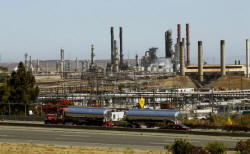|
Oil inches up as OPEC
sticks to output pledges
 Send a link to a friend
Send a link to a friend
 [March 01, 2017]
By Amanda Cooper [March 01, 2017]
By Amanda Cooper
LONDON
(Reuters) - Oil edged higher on Wednesday as investors took heart from
strict OPEC compliance with its pledge to cut output, although evidence
of increasing U.S. production capped gains.
The Organization of the Petroleum Exporting Countries reduced its oil
output for a second month in February, a Reuters survey found, showing
the exporter group has boosted already strong compliance to around 94
percent.
Heftier cuts by Saudi Arabia and Angola helped offset weaker compliance
by other members that agreed to limit their output.
May Brent crude futures <LCOc1> rose 19 cents on the day to $56.70 a
barrel at 1222 GMT, while U.S. West Texas Intermediate (WTI) futures for
April delivery <CLc1> rose 9 cents to $54.10.
Brent crude fell 0.2 percent in February, its largest slide in the
second month of the year in four years.
Oil prices are 23 percent higher than they were at the end of November,
when OPEC announced its deal, but this strength has encouraged more U.S.
production to come back online.

"There seems ... to be a consensus within OPEC that the optimal crude
oil price is as near as possible to the upper line of our shale band
price range ($40-60 a barrel) but not significantly above," Olivier
Jakob, a strategist at consultant Petromatrix, said.
"OPEC will be happy with price stability in the upper half of our shale
band (i.e. trying to keep prices in the $50-60 upper half) and above $60
a barrel, we will see more OPEC cheating as members do not want to see
U.S. shale oil come back too strongly."
[to top of second column] |

Chevron Corp's refinery is shown in Richmond, California August 7,
2012. REUTERS/Robert Galbraith/File Photo

Investors were waiting for weekly U.S. inventory data at 1530 GMT.
U.S. crude stockpiles have risen for seven straight weeks. Forecasts for
another build last week, this time of 3.1 million barrels, have fueled
worries that demand growth may not be sufficient to soak up the global
oil glut.
The market offered little reaction to news of a rise in North Sea crude
supply next month. Loading programs for the four crudes that underpin
dated Brent showed a rise to 908,000 barrels per day, from March's
884,000 bpd. [O/LOAD]
A speech by U.S. President Donald Trump late on Tuesday gave little
detail on plans by his administration to boost U.S. oil production.
Traders and investors had expected Trump to include specifics on energy
policy in an address to the U.S. Congress.
"If Trump had announced de-regulations of some of the environment
protections to make it easier to pump more oil, that might have put
pressure on WTI," said Jeffrey Halley, senior market analyst at futures
brokerage OANDA in Singapore.
(Additional reporting by Naveen Thukral in SINGAPORE; Editing by Dale
Hudsong and Susan Thomas)
[© 2017 Thomson Reuters. All rights
reserved.] Copyright 2017 Reuters. All rights reserved. This material may not be published,
broadcast, rewritten or redistributed. |